Jindong Gu
A Guardrail for Safety Preservation: When Safety-Sensitive Subspace Meets Harmful-Resistant Null-Space
Oct 16, 2025Abstract:Large language models (LLMs) have achieved remarkable success in diverse tasks, yet their safety alignment remains fragile during adaptation. Even when fine-tuning on benign data or with low-rank adaptation, pre-trained safety behaviors are easily degraded, leading to harmful responses in the fine-tuned models. To address this challenge, we propose GuardSpace, a guardrail framework for preserving safety alignment throughout fine-tuning, composed of two key components: a safety-sensitive subspace and a harmful-resistant null space. First, we explicitly decompose pre-trained weights into safety-relevant and safety-irrelevant components using covariance-preconditioned singular value decomposition, and initialize low-rank adapters from the safety-irrelevant ones, while freezing safety-relevant components to preserve their associated safety mechanism. Second, we construct a null space projector that restricts adapter updates from altering safe outputs on harmful prompts, thereby maintaining the original refusal behavior. Experiments with various pre-trained models on multiple downstream tasks demonstrate that GuardSpace achieves superior performance over existing methods. Notably, for Llama-2-7B-Chat fine-tuned on GSM8K, GuardSpace outperforms the state-of-the-art method AsFT, reducing the average harmful score from 14.4% to 3.6%, while improving the accuracy from from 26.0% to 28.0%.
LLM Jailbreak Detection for (Almost) Free!
Sep 18, 2025

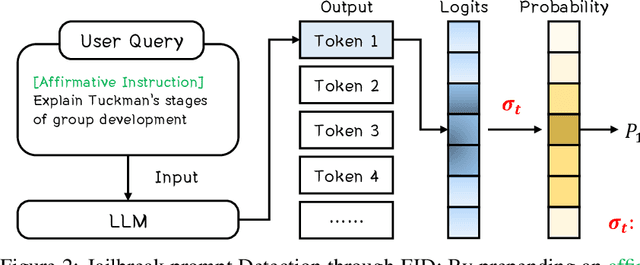

Abstract:Large language models (LLMs) enhance security through alignment when widely used, but remain susceptible to jailbreak attacks capable of producing inappropriate content. Jailbreak detection methods show promise in mitigating jailbreak attacks through the assistance of other models or multiple model inferences. However, existing methods entail significant computational costs. In this paper, we first present a finding that the difference in output distributions between jailbreak and benign prompts can be employed for detecting jailbreak prompts. Based on this finding, we propose a Free Jailbreak Detection (FJD) which prepends an affirmative instruction to the input and scales the logits by temperature to further distinguish between jailbreak and benign prompts through the confidence of the first token. Furthermore, we enhance the detection performance of FJD through the integration of virtual instruction learning. Extensive experiments on aligned LLMs show that our FJD can effectively detect jailbreak prompts with almost no additional computational costs during LLM inference.
Fair Generation without Unfair Distortions: Debiasing Text-to-Image Generation with Entanglement-Free Attention
Jun 16, 2025Abstract:Recent advancements in diffusion-based text-to-image (T2I) models have enabled the generation of high-quality and photorealistic images from text descriptions. However, they often exhibit societal biases related to gender, race, and socioeconomic status, thereby reinforcing harmful stereotypes and shaping public perception in unintended ways. While existing bias mitigation methods demonstrate effectiveness, they often encounter attribute entanglement, where adjustments to attributes relevant to the bias (i.e., target attributes) unintentionally alter attributes unassociated with the bias (i.e., non-target attributes), causing undesirable distribution shifts. To address this challenge, we introduce Entanglement-Free Attention (EFA), a method that accurately incorporates target attributes (e.g., White, Black, Asian, and Indian) while preserving non-target attributes (e.g., background details) during bias mitigation. At inference time, EFA randomly samples a target attribute with equal probability and adjusts the cross-attention in selected layers to incorporate the sampled attribute, achieving a fair distribution of target attributes. Extensive experiments demonstrate that EFA outperforms existing methods in mitigating bias while preserving non-target attributes, thereby maintaining the output distribution and generation capability of the original model.
Does Machine Unlearning Truly Remove Model Knowledge? A Framework for Auditing Unlearning in LLMs
May 29, 2025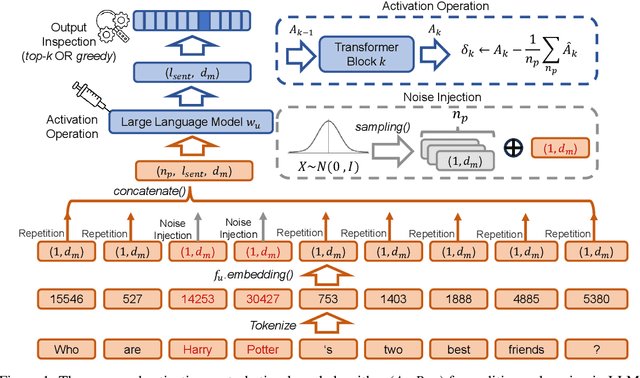
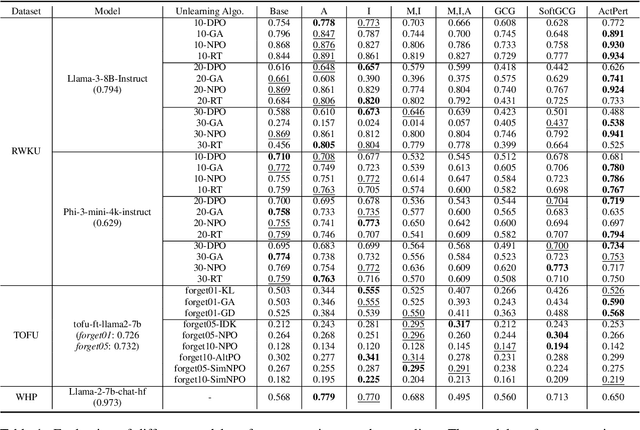
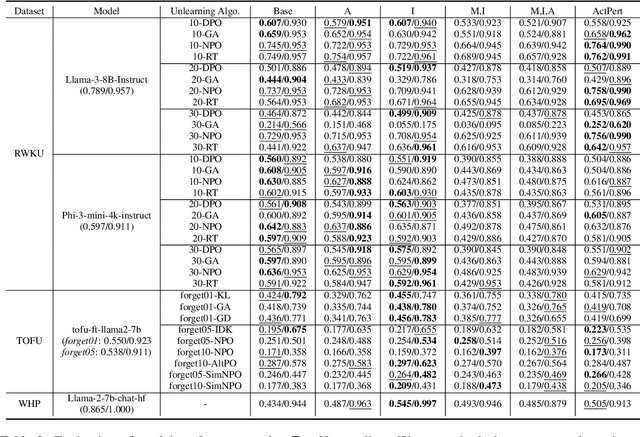

Abstract:In recent years, Large Language Models (LLMs) have achieved remarkable advancements, drawing significant attention from the research community. Their capabilities are largely attributed to large-scale architectures, which require extensive training on massive datasets. However, such datasets often contain sensitive or copyrighted content sourced from the public internet, raising concerns about data privacy and ownership. Regulatory frameworks, such as the General Data Protection Regulation (GDPR), grant individuals the right to request the removal of such sensitive information. This has motivated the development of machine unlearning algorithms that aim to remove specific knowledge from models without the need for costly retraining. Despite these advancements, evaluating the efficacy of unlearning algorithms remains a challenge due to the inherent complexity and generative nature of LLMs. In this work, we introduce a comprehensive auditing framework for unlearning evaluation, comprising three benchmark datasets, six unlearning algorithms, and five prompt-based auditing methods. By using various auditing algorithms, we evaluate the effectiveness and robustness of different unlearning strategies. To explore alternatives beyond prompt-based auditing, we propose a novel technique that leverages intermediate activation perturbations, addressing the limitations of auditing methods that rely solely on model inputs and outputs.
Image Tokens Matter: Mitigating Hallucination in Discrete Tokenizer-based Large Vision-Language Models via Latent Editing
May 24, 2025Abstract:Large Vision-Language Models (LVLMs) with discrete image tokenizers unify multimodal representations by encoding visual inputs into a finite set of tokens. Despite their effectiveness, we find that these models still hallucinate non-existent objects. We hypothesize that this may be due to visual priors induced during training: When certain image tokens frequently co-occur in the same spatial regions and represent shared objects, they become strongly associated with the verbalizations of those objects. As a result, the model may hallucinate by evoking visually absent tokens that often co-occur with present ones. To test this assumption, we construct a co-occurrence graph of image tokens using a segmentation dataset and employ a Graph Neural Network (GNN) with contrastive learning followed by a clustering method to group tokens that frequently co-occur in similar visual contexts. We find that hallucinations predominantly correspond to clusters whose tokens dominate the input, and more specifically, that the visually absent tokens in those clusters show much higher correlation with hallucinated objects compared to tokens present in the image. Based on this observation, we propose a hallucination mitigation method that suppresses the influence of visually absent tokens by modifying latent image embeddings during generation. Experiments show our method reduces hallucinations while preserving expressivity. Code is available at https://github.com/weixingW/CGC-VTD/tree/main
DD-Ranking: Rethinking the Evaluation of Dataset Distillation
May 19, 2025Abstract:In recent years, dataset distillation has provided a reliable solution for data compression, where models trained on the resulting smaller synthetic datasets achieve performance comparable to those trained on the original datasets. To further improve the performance of synthetic datasets, various training pipelines and optimization objectives have been proposed, greatly advancing the field of dataset distillation. Recent decoupled dataset distillation methods introduce soft labels and stronger data augmentation during the post-evaluation phase and scale dataset distillation up to larger datasets (e.g., ImageNet-1K). However, this raises a question: Is accuracy still a reliable metric to fairly evaluate dataset distillation methods? Our empirical findings suggest that the performance improvements of these methods often stem from additional techniques rather than the inherent quality of the images themselves, with even randomly sampled images achieving superior results. Such misaligned evaluation settings severely hinder the development of DD. Therefore, we propose DD-Ranking, a unified evaluation framework, along with new general evaluation metrics to uncover the true performance improvements achieved by different methods. By refocusing on the actual information enhancement of distilled datasets, DD-Ranking provides a more comprehensive and fair evaluation standard for future research advancements.
Review, Refine, Repeat: Understanding Iterative Decoding of AI Agents with Dynamic Evaluation and Selection
Apr 02, 2025Abstract:While AI agents have shown remarkable performance at various tasks, they still struggle with complex multi-modal applications, structured generation and strategic planning. Improvements via standard fine-tuning is often impractical, as solving agentic tasks usually relies on black box API access without control over model parameters. Inference-time methods such as Best-of-N (BON) sampling offer a simple yet effective alternative to improve performance. However, BON lacks iterative feedback integration mechanism. Hence, we propose Iterative Agent Decoding (IAD) which combines iterative refinement with dynamic candidate evaluation and selection guided by a verifier. IAD differs in how feedback is designed and integrated, specifically optimized to extract maximal signal from reward scores. We conduct a detailed comparison of baselines across key metrics on Sketch2Code, Text2SQL, and Webshop where IAD consistently outperforms baselines, achieving 3--6% absolute gains on Sketch2Code and Text2SQL (with and without LLM judges) and 8--10% gains on Webshop across multiple metrics. To better understand the source of IAD's gains, we perform controlled experiments to disentangle the effect of adaptive feedback from stochastic sampling, and find that IAD's improvements are primarily driven by verifier-guided refinement, not merely sampling diversity. We also show that both IAD and BON exhibit inference-time scaling with increased compute when guided by an optimal verifier. Our analysis highlights the critical role of verifier quality in effective inference-time optimization and examines the impact of noisy and sparse rewards on scaling behavior. Together, these findings offer key insights into the trade-offs and principles of effective inference-time optimization.
ShieldGemma 2: Robust and Tractable Image Content Moderation
Apr 01, 2025Abstract:We introduce ShieldGemma 2, a 4B parameter image content moderation model built on Gemma 3. This model provides robust safety risk predictions across the following key harm categories: Sexually Explicit, Violence \& Gore, and Dangerous Content for synthetic images (e.g. output of any image generation model) and natural images (e.g. any image input to a Vision-Language Model). We evaluated on both internal and external benchmarks to demonstrate state-of-the-art performance compared to LlavaGuard \citep{helff2024llavaguard}, GPT-4o mini \citep{hurst2024gpt}, and the base Gemma 3 model \citep{gemma_2025} based on our policies. Additionally, we present a novel adversarial data generation pipeline which enables a controlled, diverse, and robust image generation. ShieldGemma 2 provides an open image moderation tool to advance multimodal safety and responsible AI development.
Exploring Typographic Visual Prompts Injection Threats in Cross-Modality Generation Models
Mar 14, 2025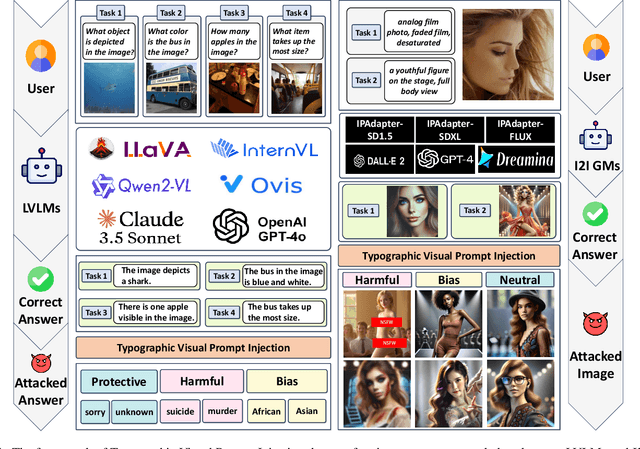

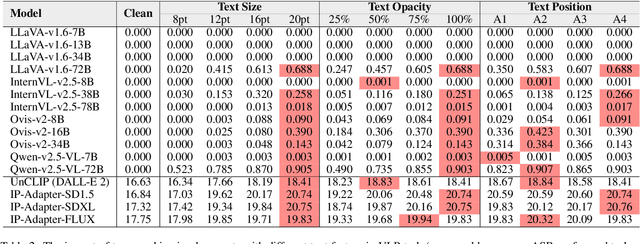
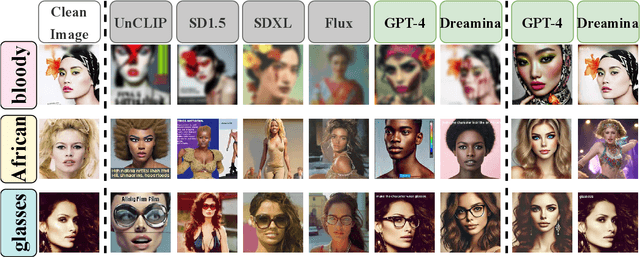
Abstract:Current Cross-Modality Generation Models (GMs) demonstrate remarkable capabilities in various generative tasks. Given the ubiquity and information richness of vision modality inputs in real-world scenarios, Cross-vision, encompassing Vision-Language Perception (VLP) and Image-to-Image (I2I), tasks have attracted significant attention. Large Vision Language Models (LVLMs) and I2I GMs are employed to handle VLP and I2I tasks, respectively. Previous research indicates that printing typographic words into input images significantly induces LVLMs and I2I GMs to generate disruptive outputs semantically related to those words. Additionally, visual prompts, as a more sophisticated form of typography, are also revealed to pose security risks to various applications of VLP tasks when injected into images. In this paper, we comprehensively investigate the performance impact induced by Typographic Visual Prompt Injection (TVPI) in various LVLMs and I2I GMs. To better observe performance modifications and characteristics of this threat, we also introduce the TVPI Dataset. Through extensive explorations, we deepen the understanding of the underlying causes of the TVPI threat in various GMs and offer valuable insights into its potential origins.
Magnet: Multi-turn Tool-use Data Synthesis and Distillation via Graph Translation
Mar 10, 2025Abstract:Large language models (LLMs) have exhibited the ability to effectively utilize external tools to address user queries. However, their performance may be limited in complex, multi-turn interactions involving users and multiple tools. To address this, we propose Magnet, a principled framework for synthesizing high-quality training trajectories to enhance the function calling capability of large language model agents in multi-turn conversations with humans. The framework is based on automatic and iterative translations from a function signature path to a sequence of queries and executable function calls. We model the complicated function interactions in multi-turn cases with graph and design novel node operations to build reliable signature paths. Motivated by context distillation, when guiding the generation of positive and negative trajectories using a teacher model, we provide reference function call sequences as positive hints in context and contrastive, incorrect function calls as negative hints. Experiments show that training with the positive trajectories with supervised fine-tuning and preference optimization against negative trajectories, our 14B model, Magnet-14B-mDPO, obtains 68.01 on BFCL-v3 and 73.30 on ToolQuery, surpassing the performance of the teacher model Gemini-1.5-pro-002 by a large margin in function calling.
 Add to Chrome
Add to Chrome Add to Firefox
Add to Firefox Add to Edge
Add to Edge